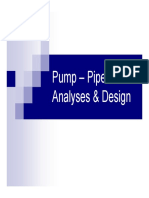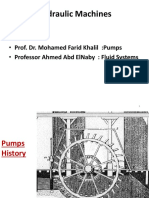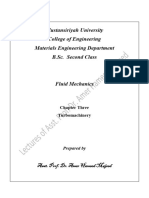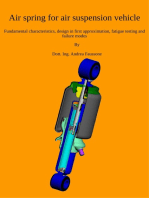cr0701ch03
Uploaded by
eng_afathycr0701ch03
Uploaded by
eng_afathy3 Concept of a
Pumping System
LIQUID TRANSFER
To truly understand pump operation, one needs to carefully examine the specifics
of each individual system in which a pump is installed and operating (see Figure
2). The main elements of a pumping system are:
• Supply side (suction or inlet side)
• Pump (with a driver)
• Delivery side (discharge or process)
The energy delivered to a pump by the driver is spent on useful energy to move
the fluid and to overcome losses:
Energyinput = Energyuseful + Losses (1)
Efficiency = Energyuseful /Energyinput (2)
Losses = Mechanical + Volumetric + Hydraulic (3)
⇓ ⇓ ⇓
bearings leakage (slip) friction
coupling entrance/exit
rubbing vortices
separation
disc friction
From the pump user viewpoint, there are two major parameters of interest:
Flow and Pressure
Flow is a parameter that tells us how much of the fluid needs to be moved
(i.e., transferring from a large storage tank to smaller drums for distribution
and sale, adding chemicals to a process, etc.).
Pressure tells us how much of the hydraulic resistance needs to be overcome
by the pumping element, in order to move the fluid.
In a perfect world of zero losses, all of the input power would go into moving
the flow against given pressure. We could say that all of the available driver power
was spent on, or transferred to, a hydraulic (i.e., useful) power. Consider the simple
0-8493-????-?/97/$0.00+$.50
© 1997 by CRC Press LLC
©1999 CRC Press LLC
Driver
Coupling
Pump
Valve Valve
FIGURE 2 Pump in a system.
illustration in Figure 3, which shows a piston steadily pushed against pressure, “p,”
inside a pipe filled with liquid. During the time “t,” the piston will travel a distance
“L,” and the person, exerting force “F” on a piston, is doing work to get this process
going. From our school days, we remember that work equals force multipled by
distance:
W=F×L (4)
For a steady motion, the force is balanced by the pressure “p,” acting on area, “A”:
W = (p × A) × L = p × (A × L) = p × V (5)
Area
Force
Volume = A x L
Travel
FIGURE 3 Concept of power transfer to the fluid.
©1999 CRC Press LLC
INPUT POWER, LOSSES, AND EFFICIENCY
Work per unit of time equals power. So, dividing both sides of the equation by “t,”
we get:
W p×V
= , (6)
t t
or,
Power = p × Q,
where
V
Q= .
t
“Q” is the volume per unit of time, which in pump language is called “flow,”
“capacity,” or “delivery.” Inside the pump, the fluid is moved against the pressure
by a piston, rotary gear, or impeller, etc. (thus far assuming no losses).
This book will use conventional U.S. nomenclature, which can easily be con-
verted to metric units using the conversion formulas located in Appendix B at the
end of the book.
So, Ideal Power = Fluid Horsepower = FHP = p × Q × constant, since all
power goes to “fluid horsepower,” in the ideal world. Typically, in U.S. units, pressure
is measured in psi, and flow in gpm, so we derive the constant:
lbf × gal in 2 ft 3 min
psi × gpm = × 144 2 × ×
in × min
2
ft 7.48 gal 60 sec
lbf × ft 144 HP = BHP .
= × ×
sec 7.48 × 60 lbf × ft 1714
550
sec
Therefore,
p×Q
FHP = . (7)
1714
This is why the “1714” constant “rings a bell” for rotary pump users and manufacturers.
©1999 CRC Press LLC
Returning to the “real world,” let us “turn on the friction” exerted by the walls
of the imperfect pipes on liquid, and consider the rubbing of the piston against the
pipe walls, as well as the “sneaking” of some of the liquid back to low pressure
through the clearances between the piston and pipe walls. BHP = FHP + Losses, or
introducing the efficiency concept:
FHP
η= , (8)
BHP
or
FHP = BHP × η.
We can now correct Equation 7 with the efficiency:
p×Q
BHP = . (9)
η × 1714
Jumping ahead a little, Equation 9 is typically used when dealing with positive
displacement pumps (which include rotary pumps), but a “centrifugal world” is more
accustomed to expressing pressure traditionally in feet of head, using specific
gravity3:
p × 2.31
H= (feet of water ) (10)
SG
which turns Equation 9 into
H × SG × Q
2.31 H × Q × SG
BHP = = . (11)
η × 1714 η × 3960
This is why a “3960” constant should now “ring a bell” for centrifugal pumps users.
Both Equation 9 and 11 produce identical results, providing that proper units are
used.
SYSTEM CURVE
From the discussion above, we have established that flow and pressure are the two
main parameters for a given application. Other parameters, such as pump speed,
fluid viscosity, specific gravity, and so on, will have an effect on flow and/or pressure,
by modifying the hydraulics of a pumping system in which a given pump operates.
A mechanism of such changes can be traced directly to one of the components of
losses, namely the hydraulic losses.
©1999 CRC Press LLC
Essentially, any flow restriction requires a pressure gradient to overcome it.
These restrictions are valves, orifices, turns, and pipe friction. From the fundamentals
of hydraulics based on the Bernoulli equation, a pressure drop (i.e., hydraulic loss)
is proportional to velocity head:
V2
h loss = K (coefficient “k” can be found in books on hydraulics).3 (12)
2g
For the flow of liquid through a duct (such as pipe), the velocity is equal to:
Q
V= (13)
A
which means that pressure loss is proportional to the square of flow:
hloss ~ Q2. (14)
If this equation is plotted, it will be a parabola (see Figure 4).
hLoss~Q2
Hydraulic Losses (hLoss)
Parabola
Flow (Q)
FIGURE 4 Hydraulic losses, as a function of flow.
PUMP CURVE
A pump curve shows a relationship between its two main parameters: flow and
pressure. The shape of this curve (see Figure 5) depends on the particular pump type.
Later on, we will show how these curves are derived. For now, it is important
to understand that the energy supplied to a pump (and from a pump to fluid) must
overcome a system resistance: mechanical, volumetric, and hydraulic losses. In terms
of pressure drop across the pump, it must be equal to the system resistance, or
demonstrated mathematically,
©1999 CRC Press LLC
Rotary (or any PD-Type)
Pressure (p), or Head (H)
Centrifugal
Flow (Q)
FIGURE 5 Pump curves, relating pressure and flow. The slope of the centrifugal pump
curve is “mostly” flat or horizontal; the slope of the PD-pump is almost a vertical line.
∆ppump = hloss, at a given flow. (15)
Therefore, the pump operating point is an intersection of the pump curve and a
system curve (see Figure 6). In addition to friction, a pump must also overcome the
elevation difference between fluid levels in the discharge and suction side tanks, a so-
called static head, that is independent of flow (see Figure 7). If pressure inside the
tanks is not equal to atmospheric pressure then the static head must be calculated as
equivalent difference between total static pressures (expressed in feet of head) at the
pump discharge and suction, usually referenced to the pump centerline (see Figure 8).
The above discussion assumes that the suction and discharge piping near the pump
flanges are of the same diameter, resulting in the same velocities. In reality, suction
and discharge pipe diameters are different (typically, a discharge pipe diameter is
smaller). This results in difference between suction and discharge velocities, and their
energies (velocity heads) must be accounted for. Therefore, a total pump head is the
difference between all three components of the discharge and suction fluid energy per
unit mass: static pressure heads, velocity heads, and elevations. For example,
p d – p s Vd2 – Vs2
H= + + (z d – z s ).1 (16)
γ 2g
Note that the units in Equation 16 are feet of head of water. The conversion between
pressure and head is:
p × 2.31
H= . (17)
SG
©1999 CRC Press LLC
(a) Centrifugal
H
Pump
System Operating point
(b) Rotary
P
Pump
System Operating point
Q slip
(c) Rotary pump
FIGURE 6 Pump operating point — intersection of a pump and a system curves.
Note: Due to the almost vertical curve slope of rotary pumps (b), their performance curves
are usually and historically plotted as shown on (c) (i.e., flow vs. pressure).
©1999 CRC Press LLC
ho
Hydraulic Losses
Zd ho = f(Q)
Zs
Pump ho
(b)
(a)
ho=Zd-Zs ho
FIGURE 7 System curves:
(a) without static head (ho = negligible)
(b) with static head
500 psig
100 psig
Zd
Zs
Pump
hd = 500 x 2.31 + Z
d
SG
hs = 100 x 2.31 + Z
s
SG
ho = hd-hs = (500-100)x2.31 + (Z -Z )
d s
SG
Correction for pressurized tanks.
FIGURE 8 “Equivalent” static head, (ho), must be corrected to account for the actual
pressure values at the surfaces of fluids in tanks.
©1999 CRC Press LLC
From our high school days and basic hydraulics, we remember that the pressure,
exerted by a column of water of height, “h,” is
p = ρgh = γ h, (18)
where γ is a specific weight of the substance, measured in lbf/ft3. A specific gravity
(SG) is defined as a ratio of the specific weight of the substance to the specific
weight of cold water: γo = 62.4 lbf/ft3. (SG is also equal to the ratio of densities,
due to a gravitational constant between the specific weight and density). So,
SG = ρ/ρo = γ/γo, (19)
p = ρgh = γ h = (γoSG)h = 62.4 × SG × h (lbf/ft2) (20)
(To obtain pressure in more often used units of lbf/in2 (psi), divide by 144).
h × SG
p= , (21)
2.31
or
p × 2.31
h=
SG
Clearly, if the system resistance changes, such as an opening or a closing of the
discharge valve, or increased friction due to smaller or longer piping, the slope of
the system curve will change (see Figure 9). The operating point moves: 1 → 2, as
valve becomes “more closed,” or 1 → 3, if it opens more.
(2)
Pressure (P) or Head (H)
(1)
50% Open
(1) (3)
Pump
10% Open
(2)
2 1 3 Flow (Q)
90% Open
(3)
FIGURE 9 System curves at different resistance.
©1999 CRC Press LLC
You might also like
- Mechanical - Pumps KSB Centrifugal Pump Design100% (3)Mechanical - Pumps KSB Centrifugal Pump Design44 pages
- 5 - Pump-Pipeline System Analyses DesignNo ratings yet5 - Pump-Pipeline System Analyses Design25 pages
- Concept of A Pumping System: Liquid TransferNo ratings yetConcept of A Pumping System: Liquid Transfer9 pages
- (A) Centrifugal Pumps & System HydraulicsNo ratings yet(A) Centrifugal Pumps & System Hydraulics24 pages
- Centrifugal Pumps and System HydraulicsNo ratings yetCentrifugal Pumps and System Hydraulics23 pages
- PE-system Hydraulic Design of Liquid or Water Pumping Circuit PDFNo ratings yetPE-system Hydraulic Design of Liquid or Water Pumping Circuit PDF25 pages
- PE-System Hydraulic Design of Liquid or Water Pumping CircuitNo ratings yetPE-System Hydraulic Design of Liquid or Water Pumping Circuit25 pages
- Mechanical Processes and Equipments MP - C7No ratings yetMechanical Processes and Equipments MP - C740 pages
- G8 FM3 Centrifugal Pump CharacteristicsNo ratings yetG8 FM3 Centrifugal Pump Characteristics20 pages
- Pump Knowledge - Centrifugal Pump Part 1No ratings yetPump Knowledge - Centrifugal Pump Part 161 pages
- MPE - W7 - Transportation of Fluids - Pumps - 2024No ratings yetMPE - W7 - Transportation of Fluids - Pumps - 202439 pages
- Basic Pump Parameters and The Affinity Laws: Pdhonline Course M125 (3 PDH)No ratings yetBasic Pump Parameters and The Affinity Laws: Pdhonline Course M125 (3 PDH)14 pages
- Useful Pump & Hydraulic Engineering Data Definitions, Equations, Testing, Tables, Charts DeterminationsNo ratings yetUseful Pump & Hydraulic Engineering Data Definitions, Equations, Testing, Tables, Charts Determinations12 pages
- Modern Borehole Analytics: Annular Flow, Hole Cleaning, and Pressure ControlFrom EverandModern Borehole Analytics: Annular Flow, Hole Cleaning, and Pressure ControlNo ratings yet
- Stability of Dimensionally Stable Anode For Chlorine Evolution ReactionNo ratings yetStability of Dimensionally Stable Anode For Chlorine Evolution Reaction11 pages
- Technical Guidance For Microbiology Incubators DRAFTNo ratings yetTechnical Guidance For Microbiology Incubators DRAFT15 pages
- XV Portuguese Conference On Fracture, PCF 2016, 10-12 February 2016, Paço de Arcos, PortugalNo ratings yetXV Portuguese Conference On Fracture, PCF 2016, 10-12 February 2016, Paço de Arcos, Portugal12 pages
- (Thesis) Barge Collison Analysis of Bridge PierNo ratings yet(Thesis) Barge Collison Analysis of Bridge Pier102 pages
- Beam Splice - Flange&Web Plate Rev 0 (JIS Steel)No ratings yetBeam Splice - Flange&Web Plate Rev 0 (JIS Steel)37 pages
- Lecture - 5 - CVNG 2009 - Soil Mechanics 2No ratings yetLecture - 5 - CVNG 2009 - Soil Mechanics 210 pages
- Effect of Podium Interferences On The Shear Force Distribution in RC Wall Supporting Buildings100% (1)Effect of Podium Interferences On The Shear Force Distribution in RC Wall Supporting Buildings19 pages
- Vsip - Info - Fhwa Design For Soil Nail Walls SLD Method 4 PDF FreeNo ratings yetVsip - Info - Fhwa Design For Soil Nail Walls SLD Method 4 PDF Free5 pages
- Experimental Study of The XY-Friction Pendulum Bearing For Bridge ApplicationsNo ratings yetExperimental Study of The XY-Friction Pendulum Bearing For Bridge Applications10 pages
- Glass Capillary Kinematic Viscometers: Standard Specifications and Operating Instructions ForNo ratings yetGlass Capillary Kinematic Viscometers: Standard Specifications and Operating Instructions For26 pages
- Fluids Review Supplemental Notes - 023609No ratings yetFluids Review Supplemental Notes - 02360918 pages
- Engineering Thermodynamics Solutions ManualNo ratings yetEngineering Thermodynamics Solutions Manual32 pages
- Computational Contact Mechanics YastrebovNo ratings yetComputational Contact Mechanics Yastrebov308 pages
- GBT-based Analysis of Tapered Thin-Walled Members: Recent DevelopmentsNo ratings yetGBT-based Analysis of Tapered Thin-Walled Members: Recent Developments12 pages
- Project Report ON " Issac Newton ": Submitted To D. P. Vipra College Bilaspur (C.G.)No ratings yetProject Report ON " Issac Newton ": Submitted To D. P. Vipra College Bilaspur (C.G.)17 pages
- PE-system Hydraulic Design of Liquid or Water Pumping Circuit PDFPE-system Hydraulic Design of Liquid or Water Pumping Circuit PDF
- PE-System Hydraulic Design of Liquid or Water Pumping CircuitPE-System Hydraulic Design of Liquid or Water Pumping Circuit
- MPE - W7 - Transportation of Fluids - Pumps - 2024MPE - W7 - Transportation of Fluids - Pumps - 2024
- Basic Pump Parameters and The Affinity Laws: Pdhonline Course M125 (3 PDH)Basic Pump Parameters and The Affinity Laws: Pdhonline Course M125 (3 PDH)
- Useful Pump & Hydraulic Engineering Data Definitions, Equations, Testing, Tables, Charts DeterminationsUseful Pump & Hydraulic Engineering Data Definitions, Equations, Testing, Tables, Charts Determinations
- Steam Engines Machinery's Reference Series, Number 70From EverandSteam Engines Machinery's Reference Series, Number 70
- Discrete Mechanics: Concepts and ApplicationsFrom EverandDiscrete Mechanics: Concepts and Applications
- Modern Borehole Analytics: Annular Flow, Hole Cleaning, and Pressure ControlFrom EverandModern Borehole Analytics: Annular Flow, Hole Cleaning, and Pressure Control
- Shortcuts to College Calculus Refreshment KitFrom EverandShortcuts to College Calculus Refreshment Kit
- Stability of Dimensionally Stable Anode For Chlorine Evolution ReactionStability of Dimensionally Stable Anode For Chlorine Evolution Reaction
- Technical Guidance For Microbiology Incubators DRAFTTechnical Guidance For Microbiology Incubators DRAFT
- XV Portuguese Conference On Fracture, PCF 2016, 10-12 February 2016, Paço de Arcos, PortugalXV Portuguese Conference On Fracture, PCF 2016, 10-12 February 2016, Paço de Arcos, Portugal
- Effect of Podium Interferences On The Shear Force Distribution in RC Wall Supporting BuildingsEffect of Podium Interferences On The Shear Force Distribution in RC Wall Supporting Buildings
- Vsip - Info - Fhwa Design For Soil Nail Walls SLD Method 4 PDF FreeVsip - Info - Fhwa Design For Soil Nail Walls SLD Method 4 PDF Free
- Experimental Study of The XY-Friction Pendulum Bearing For Bridge ApplicationsExperimental Study of The XY-Friction Pendulum Bearing For Bridge Applications
- Glass Capillary Kinematic Viscometers: Standard Specifications and Operating Instructions ForGlass Capillary Kinematic Viscometers: Standard Specifications and Operating Instructions For
- GBT-based Analysis of Tapered Thin-Walled Members: Recent DevelopmentsGBT-based Analysis of Tapered Thin-Walled Members: Recent Developments
- Project Report ON " Issac Newton ": Submitted To D. P. Vipra College Bilaspur (C.G.)Project Report ON " Issac Newton ": Submitted To D. P. Vipra College Bilaspur (C.G.)






























































































